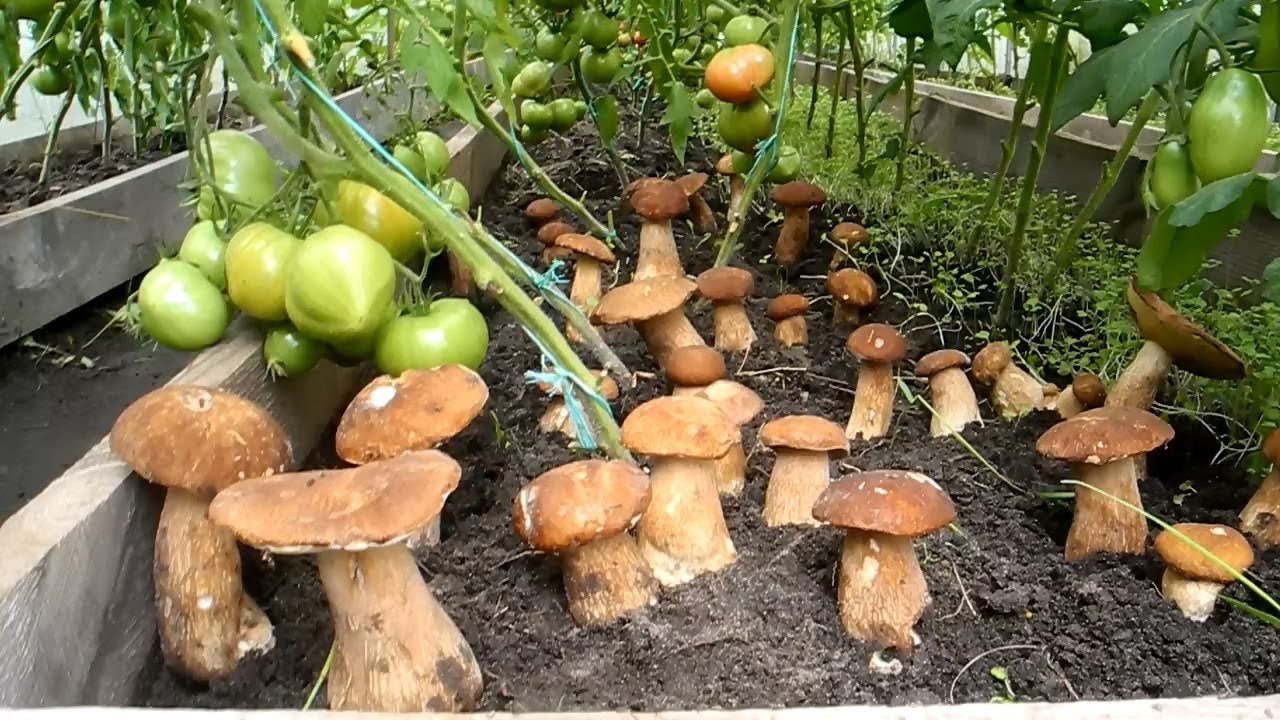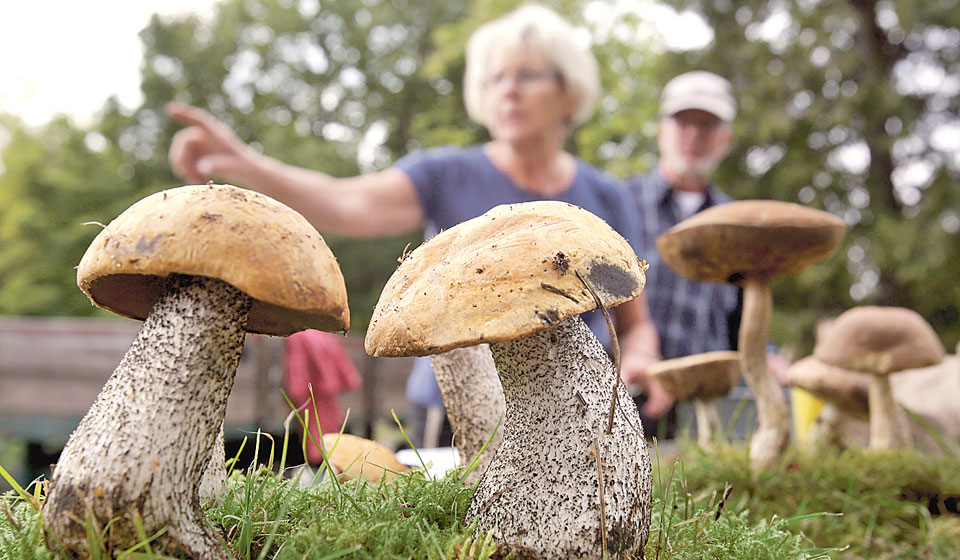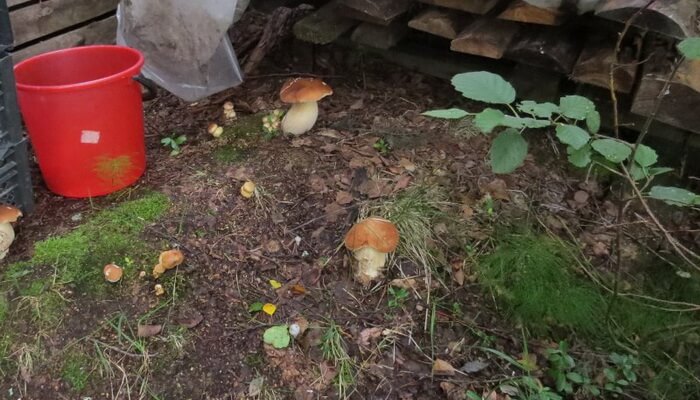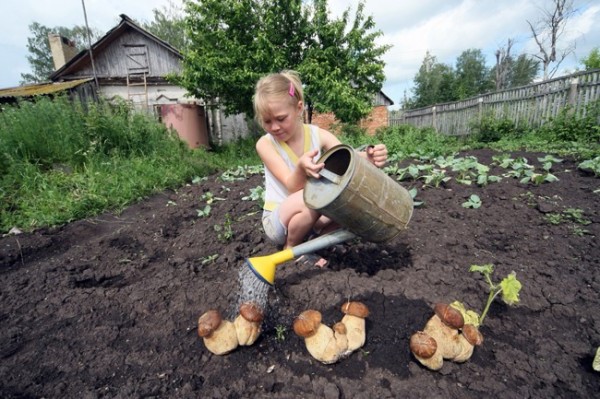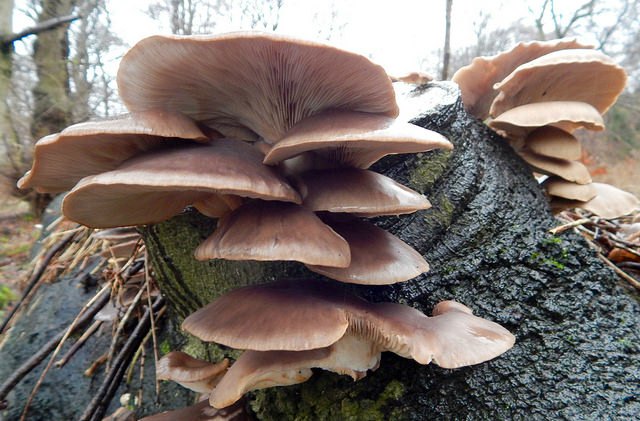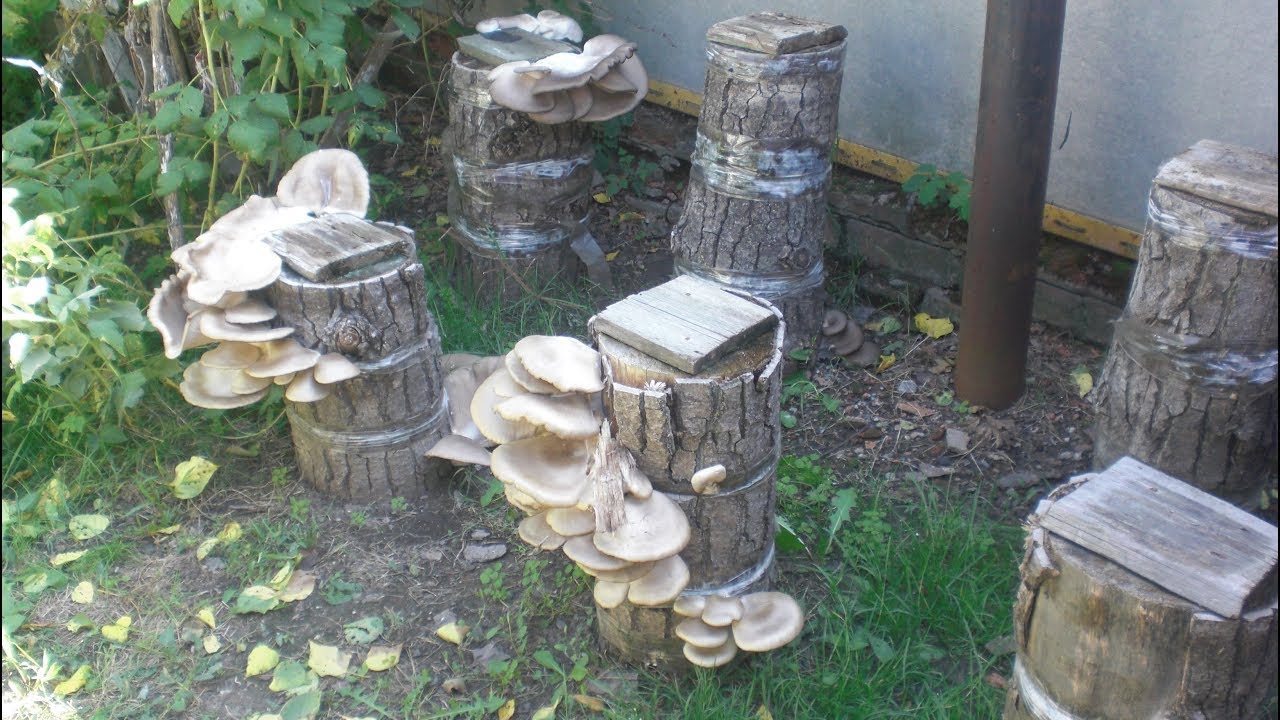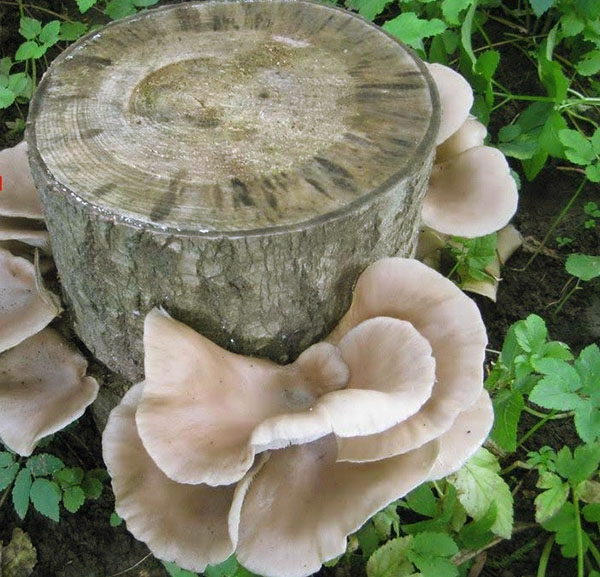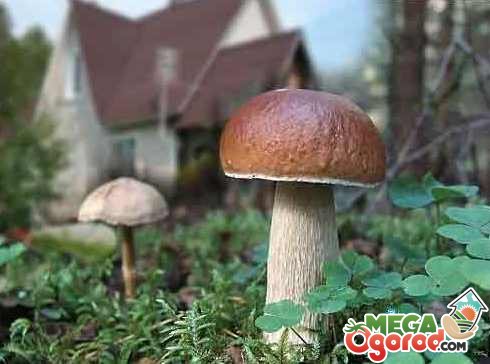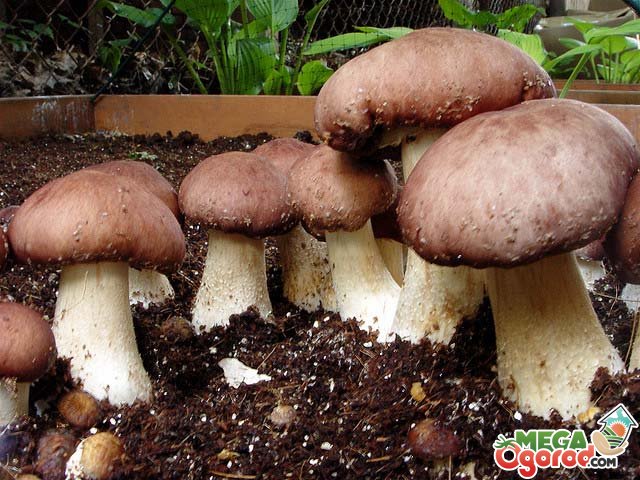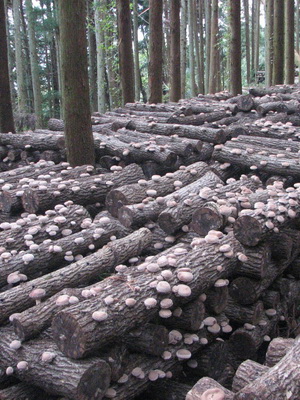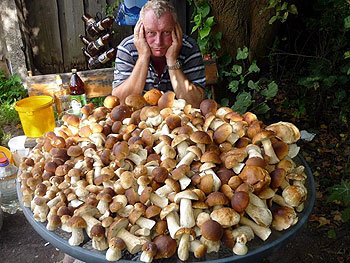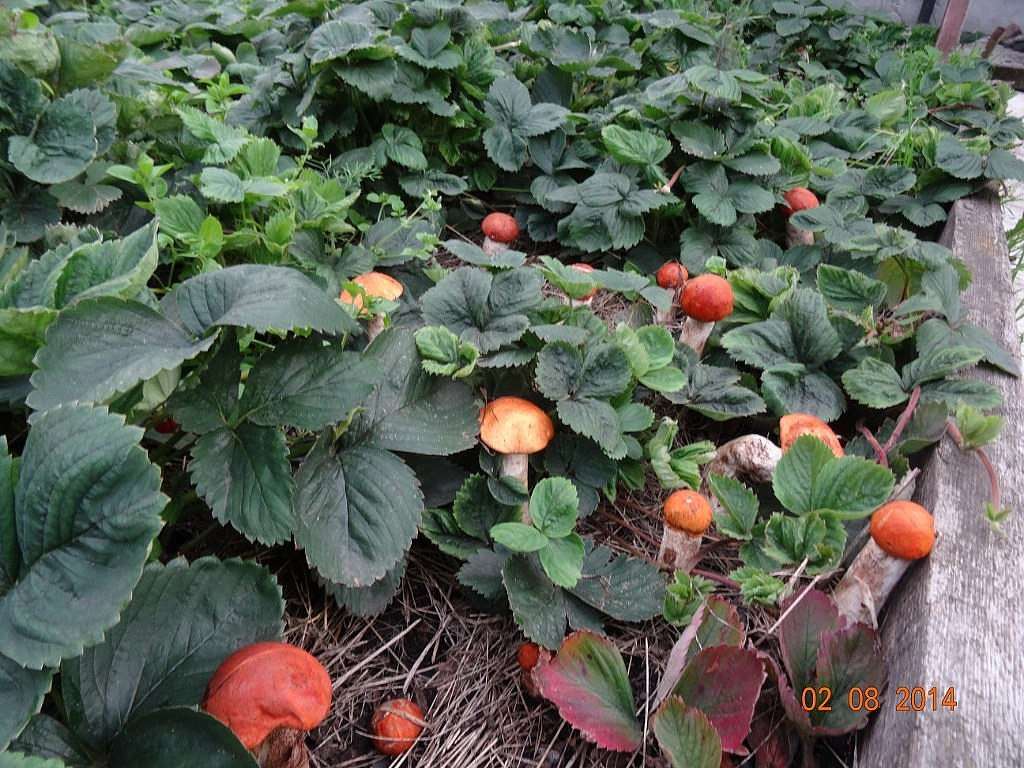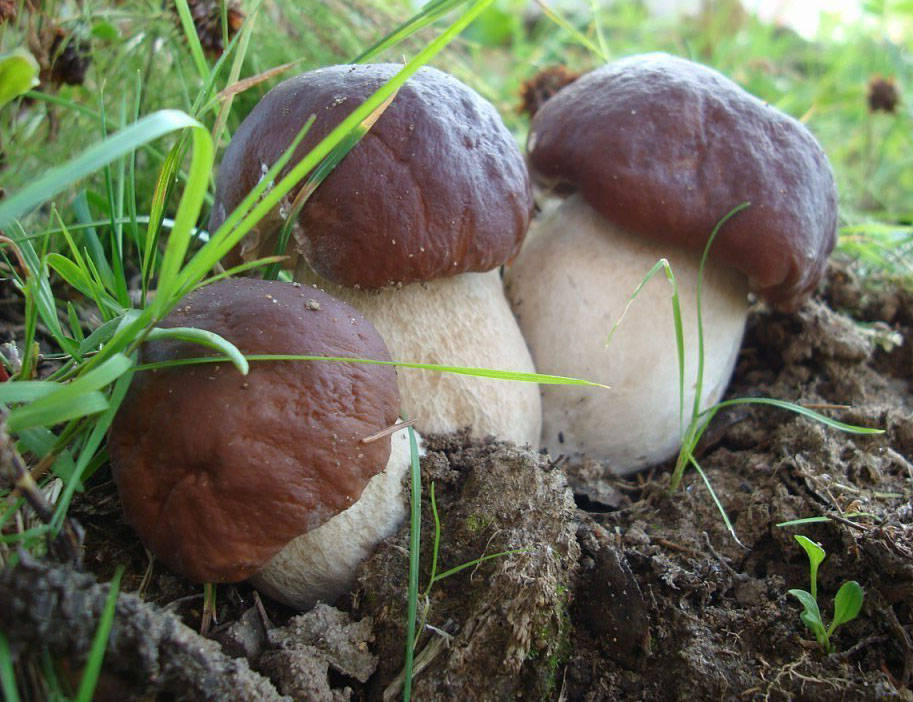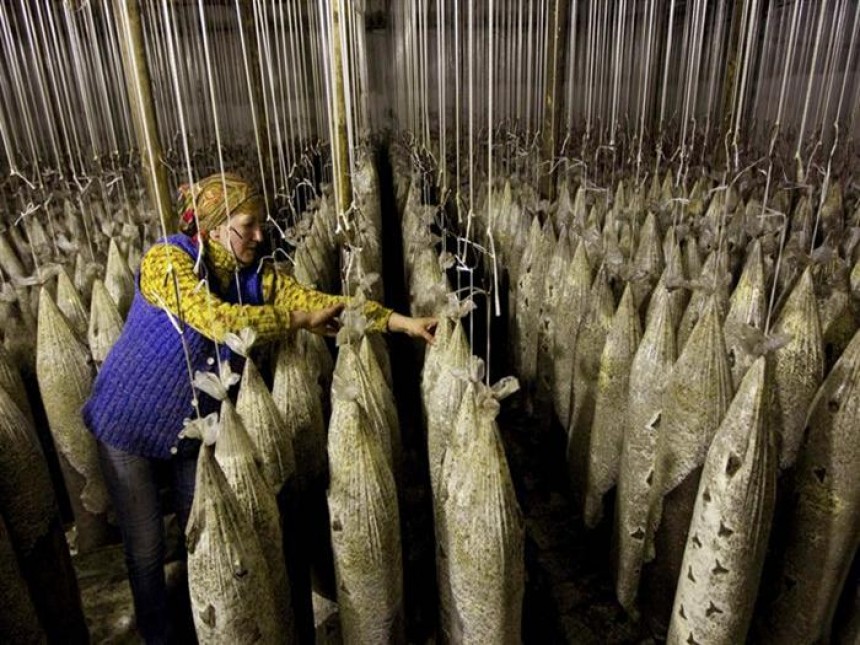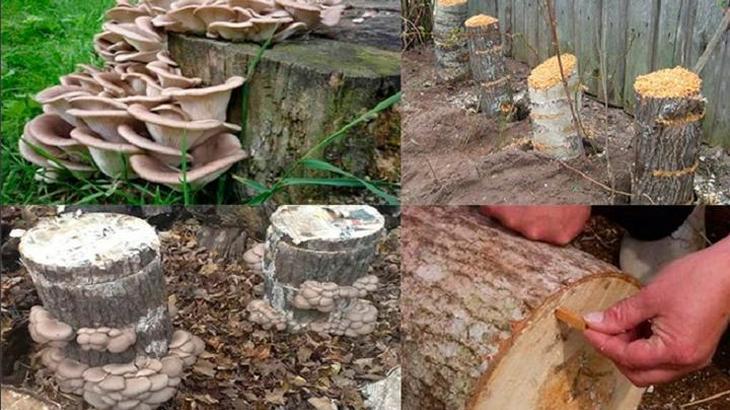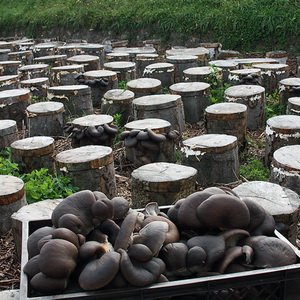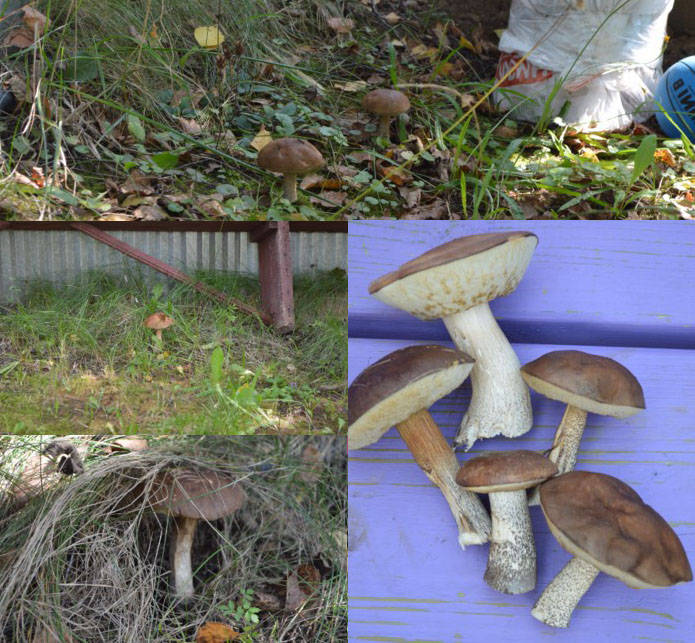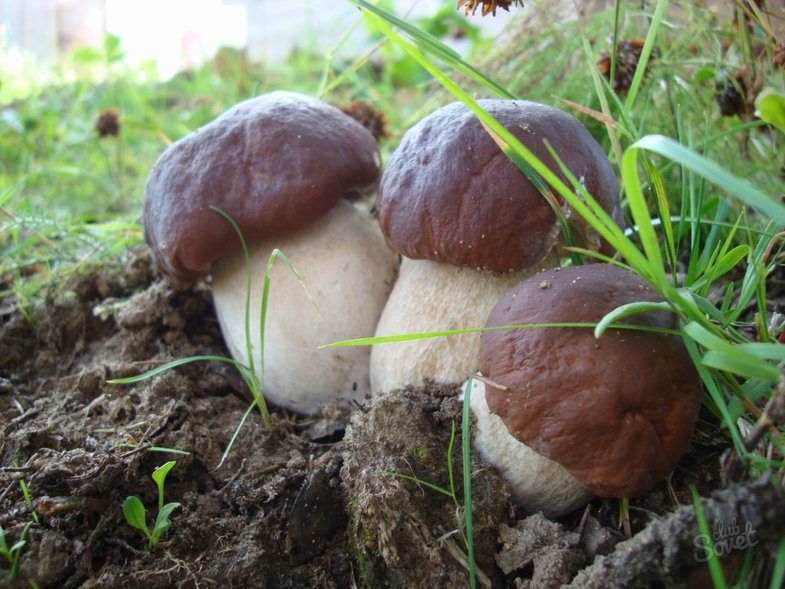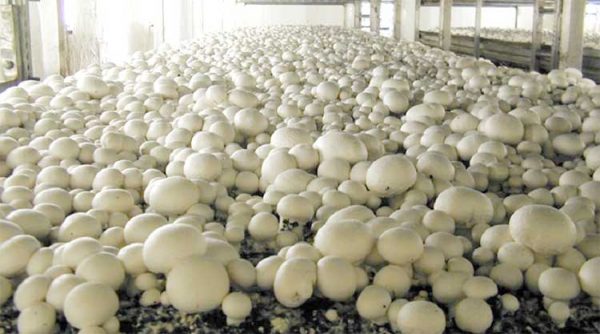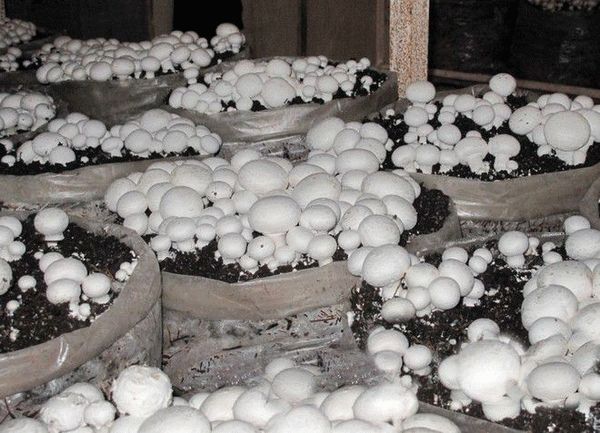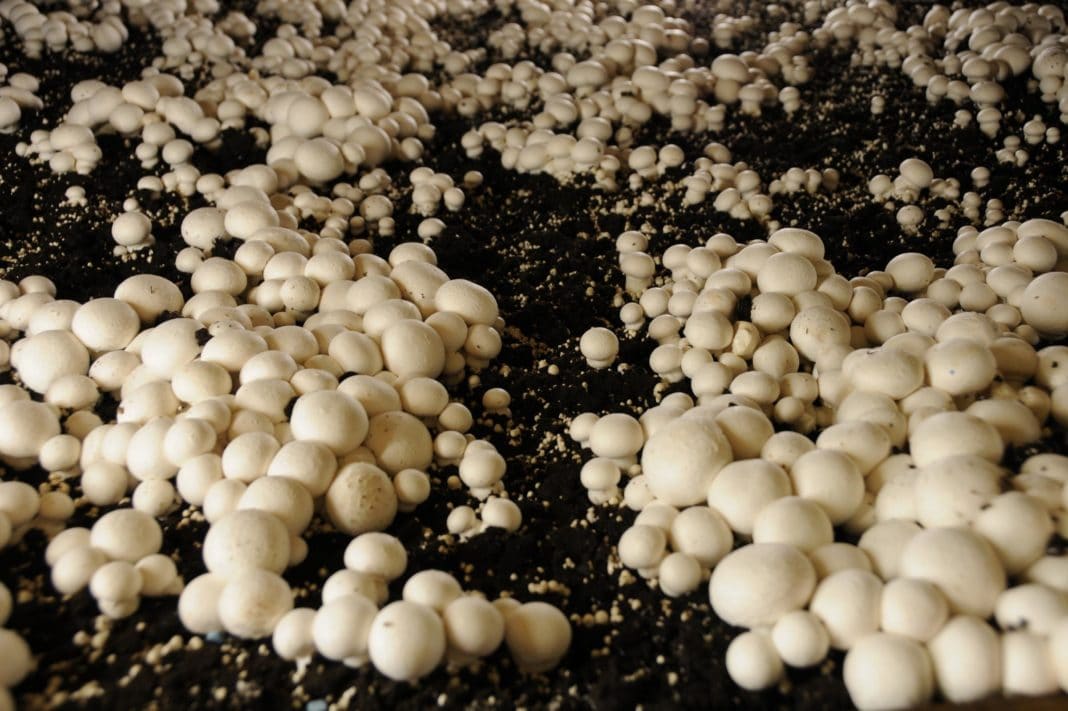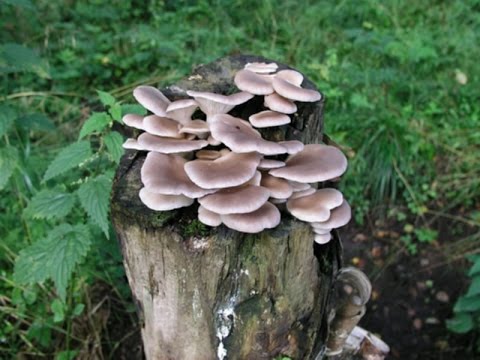Boletus
For planting boletus, it is recommended to choose areas with a large number of birches in the area. It is preliminarily recommended to purchase mycelium, compost, soil for home flowers. A larger crop is obtained on soil fertilized with peat.
The use of mycelium is considered the easiest way; May-end of summer is considered a suitable period. On a site previously cleared of debris, 3 pits should be made for seed of 10x20 cm in size. The dug holes are filled with 1/2 peat soil, mycelium is laid out in each hole. The tamped wells should be watered with 1 liter of water.
How to grow mushrooms at home in a bank
This method is suitable for growing honey agarics.
- You will need a three-liter jar, into which the necessary substrate is poured for nutrition.
- Then it must be put in a water bath and boiled for 2 hours over low heat.
- When the jar has completely cooled down, the mycelium is colonized on top of the substrate.
- Cover the container with gauze or other mesh cloth and leave it in the room.
- After 3 weeks, the mycelium will begin to sprout. When he does this, he will need to move the jar to a more ventilated and cooler area. For example, on the balcony so that the direct rays of the sun do not fall on it, but there is also no strong shadow. Honey mushrooms will start to grow actively. To prevent them from breaking, you can wrap the neck in cardboard or cover with a large plastic cup.
The crop is cut off, after which you can repeat the procedure again. After 2 weeks with proper cultivation, you will already have a second crop.
Harvesting mushrooms in the country
To obtain the maximum yield with the best qualities, the mushrooms are harvested at regular intervals.
Champignon. The first harvest of these mushrooms in the country is carried out 1-1.5 months after sowing, and the subsequent ones - within 2-4 months. The mushrooms are harvested while the protective film between the edges of the cap and the stem is intact. They are unscrewed from the ground, and the resulting hole is immediately filled up. The second crop appears a week after the first is harvested. You can harvest up to seven harvests a year, of which in the first 2-3 the mushrooms will be the largest.
Oyster mushrooms. The crop is harvested three times, every 1.5-2 weeks. The first batch is the largest. Mushrooms are cut off together, without waiting for the small ones to grow to the largest ones. They are fragile, therefore it is recommended to shift them as little as possible and immediately pack them into packaging containers.
Honey mushrooms. The crop is harvested twice a year - in May-June and autumn. The mushrooms are cut with a knife, and the slices are sprinkled with moistened sawdust. The first two batches are more plentiful.
Boletus. The crop is harvested at the end of summer. Mushrooms are cut with a knife, keeping the mycelium in the ground. Up to a whole bucket of boletus can be collected under one tree.
Morels. In the spring, the insulating layer of last year's leaves is removed from the beds, and after 2-3 weeks mushrooms appear on them. When collecting them, they are twisted by the leg or cut with a knife. Morels are fragile, so it is better not to touch the caps with your hands.
Shiitake. After the appearance of fruiting bodies, their development to fungi occurs in 10-15 days. From each block, two harvests are harvested with an interval of 7-14 days. Mushrooms are cut at different stages of development, but the harvest will be larger if you do this as soon as the edges of the caps are slightly bent. After the end of fruiting, the logs are placed in a woodpile and covered from light with a cotton cloth or straw and polyethylene, and after 1-3 months they are soaked in water and re-exposed in an open place or indoors. You can get 2-3 harvests per year. Such fruiting has been observed for 5 years. After each harvest, the substrate blocks are soaked in water for 1-2 days and dried at a temperature of 10-16 ° C.
It is better to cut the mushrooms with a sharp knife in order to keep the mycelium in the ground and prevent fresh soil from entering the container with the collected mushrooms, which usually remains on the stem when picking the mushrooms with your hands.
How to grow oyster mushrooms and shiitake mushrooms in the country
Oyster mushrooms and shiitake are also among the most popular mushrooms cultivated around the world. Shiitake is not only eaten, it is used to treat and prevent a number of diseases, including cancer. Unlike champignons, these mushrooms in the wild live on trees, including dead ones.
Therefore, to grow them, you need to bring several trunks of aspen, poplar, alder to the site. The diameter of the trunks should not be less than 15 - 20 cm. The trunks should be from healthy living trees. This does not mean that you have to chop down a tree. Those that are broken or knocked down by bad weather will also do.
The harvested trunk is sawn into chocks, up to 0.4 m long. Over the entire surface, you need to make 10 - 20 holes, up to 4-5 cm deep and 2-3 in diameter. The holes are positioned evenly on one side. In the future, the mycelium of the mushrooms will be laid in them. Oyster mushrooms and shiitake mushrooms can be purchased at the store.
After filling with mycelium, the hole is covered with moss. If the pieces of mycelium are small, then the holes for them are needed small, and after filling them, they are simply covered with beeswax. The chocks themselves need to be dug in the shade of trees or shrubs, burying 10-15 cm into the soil.
The place for placing the chocks should be shady and damp. Given that the mycelium on the chocks will develop for a long time, everything must be prepared in April, when the air temperature will be + 15 degrees. Even if the temperature drops sometimes, it is not scary for oyster mushrooms and shiitake mushrooms.
It is important to moisturize the chocks for the entire period. The mycelium grows for about two months, and after 90 days the first harvest can be expected.
Lumps inhabited by oyster mushrooms or shiitake mushrooms can bear fruit from 3 to 6 years. A similar technology can be used to grow forest mushrooms.
Cultivation of porcini mushrooms (boletus)
This handsome man, the king of all mushrooms, can be safely moved from the forest to your site, and with a favorable outcome, you will get an impressive harvest next year. There are several ways to breed forest boletus.
Mycelium transplant
Few resort to this method, since the outcome of the operation depends on careful adherence to the technology. Judge for yourself, it is quite difficult to dig out the mycelium and transfer it to your site, while not damaging it. Nevertheless, many have succeeded, you should try it too.
The transferred mycelium should interact with the roots of shrubs and trees, so choose a place on the site where deciduous or coniferous trees and bushes grow! It is extremely important to plant a porcini mushroom under the same tree from under which the mycelium was dug. So, choose a suitable place on your site and prepare the land next to the desired tree
To do this, remove 20-30 cm of the topsoil at a distance of 0.5 m from the tree trunk. At the bottom of the formed hole, lay the prepared compost from fallen leaves and tree dust, and sprinkle it on top with a small layer of earth. Now you can lay a layer of earth with mycelium, water and sprinkle with a layer of leaves. If the weather is dry in the first 14 days after planting, periodically water the mycelium
So, choose a suitable place on your site and prepare the ground next to the desired tree. To do this, remove 20-30 cm of the topsoil at a distance of 0.5 m from the tree trunk. At the bottom of the formed hole, lay the prepared compost from fallen leaves and tree dust, and sprinkle it on top with a small layer of earth. Now you can lay a layer of earth with mycelium, water and sprinkle with a layer of leaves. If the weather is dry in the first 14 days after planting, periodically water the mycelium.
Growing mushrooms from mycelium
One of the most popular methods among mushroom pickers.Ready-made mycelium can be purchased - it is readily available in many garden stores. Before proceeding with this method, prepare the site and soil. Choose a location in the shade of trees where the soil is moist. At a distance of 0.5 m from the tree trunk, remove the top layer of earth to a depth of 0.5 m. Calculate the area of the fossa in advance, based on the amount of acquired mycelium.
This is what mushroom mycelium looks like.
Prepare a substrate from dust, sawdust and leaves. Lay it on the bottom of the hole in a layer of about 20 cm. Sprinkle with soil on top (about 10 cm). Next, lay a mixed layer of soil and compost. Now, on top of this, you can put mycelium mixed with the ground. Spread it out by hand, tamping evenly. Sprinkle on top with soil and water, cover with fallen leaves.
Ready-made substrates for planting porcini mushrooms, as well as mycelium, are sold in specialized stores. These mixtures are a great alternative to forest mushrooms. After planting the mycelium, the area must be watered regularly. If the planting of the mycelium is successful, then the harvest will appear as early as next year. Such a mycelium can bear fruit from 2 to 5 years.
Mushroom seedlings
The easiest way to grow porcini mushrooms is from mushroom seedlings. To do this, it is enough to finely chop or pass the mushroom caps through a meat grinder. Then pour the resulting substance with water and leave for 24 hours. During this time, you can start preparing the site. Dig up the soil under your chosen tree and fertilize it generously with compost (same as above). Pour the mushroom infusion over the prepared place, and sprinkle with leaves on top.
If there are no forest trees on your site, do not despair - try planting mushrooms near wooden buildings on the shady side. And remember that the porcini mushroom does not like fruit trees, so try to avoid such a neighborhood.
In cold winters, do not forget to sprinkle the myceliums with compost, and if necessary, cover with polyethylene or roofing felt.
Year after year, cleaning and washing the mushrooms collected in the forest, cleaning and trimming from them, we finely chop, practically rub with our fingers, and together with the water we pour it under the birch and pine trees on the site. Including mountain pine and thuja. Now we regularly collect boletus mushrooms on the lawn, under the spruce - white, and in the area of the previously uprooted stump - honey agarics. Previously, it was thought that only legs with soil were suitable for brood, it turned out that mushroom spores are mainly under the caps.
The optimal time for planting porcini mushrooms is from May to September. Mushrooms should be planted in the ground at dusk.
Growing boletus (redheads)
As you may have guessed from the name, this mushroom mainly grows in aspen groves. Sometimes it can also be found in a mixed forest. If you undertake to grow a mushroom in the country, then the issue of choosing a site should be approached as carefully as in the case of a porcini mushroom.
Boletus, like many other forest mushrooms, belongs to mycorrhizal fungi. This means that it forms symbiosis with the roots of trees, i.e. mutually beneficial cohabitation. Therefore, the site must be aspen, birch or oak. In the shade of these trees and plant your future plantation.
Boletus boletus can be bred using:
Spore (mushroom seedlings)
Spores form on the underside of the caps of overgrown mushrooms. Here you should prepare them: pour water and leave for several hours. With the resulting infusion of spores in water, pour the area you have chosen for growing mushrooms. The caps can also be dried and used as seed. Germinating spores form the mycelium (mycelium).
Fruit bodies
Gather young boletus in the forest, chop and bury in your area in the upper soil layer in the shade of trees.
Mycelium
Wild Mycelium can be harvested from the forest by digging up with soil and trees. Thus, you will move the mycelium to your site, just like in the case of boletus.Alternatively, you can buy ready-made mycelium from the store.
Mushroom plantation and care
Prepare compost. Spread a plastic wrap on the ground, lay on it in layers, leaves and wood dust with manure, taken in a ratio of 9: 1. Cover a bunch of warm water and let it sit for a week. During this time, it should warm up to a temperature of 35-40 ° C. Now it can be shoveled until smooth and left for another 5 days.
You can plant redheads with mid-May to September (in warmer regions - from the beginning of May).
In the selected area around the tree, dig a hole 30 cm deep and 2 square meters in area. If the roots of the tree are on or close to the surface of the soil, remove only the top layer.
Fill the pit with compost. If it is deep, then put the compost to ground level, in a shallow one - spread in layers, alternating between compost (10-12 cm) and soil (5-6 cm), until the height of the layers reaches 50 cm above ground level.
Then, at a distance of 25-30 cm, make holes 20 cm deep. Dip pieces of boletus mycelium into them and cover them with soil. Immediately water the plantation with 20 liters of water per square meter and cover with a layer of fallen leaves or forest floor.
Do not forget to insulate the mycelium for the winter.
In order for the mycelium to take root, it is useful to feed it with a sugar solution: 10 g of sugar per 10 liters of water. Keep the soil slightly moist in the summer. Water the area periodically, especially during dry periods. For the winter, cover it with a layer of fallen leaves, moss or spruce branches, and do not forget to remove them in the spring.
Under favorable conditions, the fruiting of boletus begins the next year after the establishment of the plantation. The yield is 5-15 mushrooms from 1 sq. M. With proper care, a mushroom meadow will delight you with a harvest for 4-5 years. After this period, the mycelium of the mushrooms must be planted again using the same method.
Diseases of fungi
Growing mushrooms in the country and in the garden in various ways, with preparation, cultivation and harvesting, will be successful only if you protect the mushrooms from disease. Diseases and parasites often affect fungi, and if these dangers are not eliminated in time, there is a risk of losing the entire crop, which is sometimes difficult to grow.
False truffle disease
The essence of the disease is that the mycelium of the false truffle infects cultivated fungi and causes their gradual death. Control measures - when planting with the help of mycelium, exclude its contact with untreated soil. It is advisable to take the earth in a store, or treat it with a solution of potassium permanganate or iodine. Unfortunately, the family affected by the disease can only be destroyed, the earth can be ignited in a fire, the subsequent soils can be treated with a 1% solution of copper sulfate with water.

Mycogonosis or white rot
It appears as a result of improper temperature conditions and watering. As a result, mushrooms are born underdeveloped and weak. The infected crop is cut, the growing area is treated with a special disinfectant solution. If mushrooms are grown indoors (garage, utility room), it must be treated with special chemicals. It is extremely dangerous to breathe in contaminated spores, it causes a number of certain diseases already in humans.
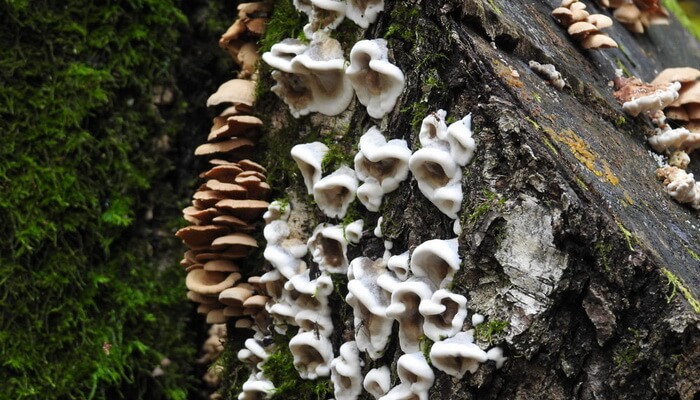
Dry rot
The tissue of the fungus begins to gradually collapse, the fruiting body becomes rotten. In the final stage, it literally dissipates, the leg darkens.
Carmine mold
A very common disease among fungi. It represents first white threads, then a fluffy white cap on the top of the mushroom. Over time, it changes color and becomes cherry. The disease can only be combated prophylactically - it is necessary to carefully use nitrogen fertilizers, as well as observe moderate watering, and prevent overflow.
In the event of a disease, the substrate must be changed, the already grown mushrooms must be destroyed in order to avoid a mass epidemic. In the open ground, disinfection is carried out either with potassium permanganate, or a weak solution of copper sulfate is used.
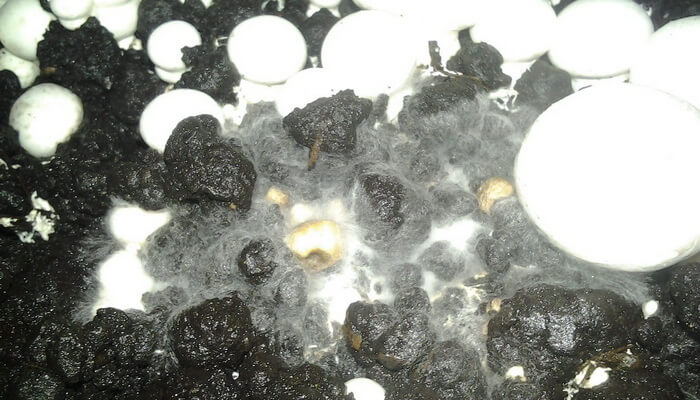
Rusty spot
Appears due to excess moisture, although it can occur with moderate watering. To grow forest mushrooms in the country in the open field, you must both observe the irrigation regime and monitor the appearance of unusual formations. If you notice rusty spots, you must remove the already infected samples and add chlorine-containing preparations to the irrigation water, or use other disinfectants. It is necessary to process the soil and caps, as well as the legs of the mushrooms.

Insect pests
Fungi can also be attacked by insects. The most common pests include:
- Mushroom mite. Appears when using fresh manure as soil or fertilizer. The mite larvae eat through the kind of tunnels in the fungus, which can often be seen on the fruiting body. As such, there is no cure, the infected crop must be destroyed, the topsoil must be calcined or treated with strong insecticidal preparations.
- Mushroom mosquito. The insect lays the larvae and gnaws through the passages in the body of the fungus. Prevention consists in the installation of very small mosquito nets (ordinary mosquitoes will not work, they have too wide "cells"), periodic treatment of the soil with insecticidal preparations. There is no cure as such, the only way out is to destroy the infected samples.
Not all fungal diseases are listed above. It is worth remembering that almost all treatment is to destroy the crop, so do not be lazy to use preventive measures.
Now you know how to grow forest mushrooms in the country in the open field, and photos and videos with practical tips and tricks will help you with this. Information about diseases of fungi and their prevention, treatment rules will help you grow mushrooms on your own site.
What mushrooms can be planted in the country?
Almost any forest mushrooms can be successfully grown in your local area. The most common mushrooms in the country are:
- boletus;
- White mushroom;
- boletus;
- oiler;
- saffron milk cap.
How to grow champignon mushrooms?
Champignons can be grown in bags, boxes, in the garden. A richer harvest will give cultivation in artificial conditions, that is, in bags or in boxes. Plus, you can better control diseases and pests by simply isolating infected containers. So, to the question of how best to grow mushrooms at home, the answer is to create suitable conditions indoors.
For growing mushrooms, a simple straw or sawdust substrate will not be enough. You will need good quality compost made from rotted straw and rye or wheat seeds. It can be purchased from agricultural organizations. To it you need to add horse manure (up to 80% of the total) or mullein. Poultry droppings will do, but the yield will be lower. This substrate is filled with mycelium at the rate of 400-500 g per square meter.
So, how to grow mushrooms in the country? After putting the mycelium in bags with the substrate, you need to wait 3 days, then make 5-6 cuts in each bag and leave in the dark at a temperature of + 18-20 ° С. After 2-3 weeks, the first mushrooms will appear in the slots. At this moment, you need to transfer the bags to a ventilated and illuminated room around the clock with a temperature of + 20-27 ° C and high humidity (70-95%). Champignons will grow to their intended size in 3-4 weeks. Having collected their harvest, you need to transfer the bags to a dark room again, where after a week they will begin to grow again.
Growing porcini mushrooms in the country
The king of mushrooms grows successfully in a well-prepared area. How to grow these mushrooms in the country? To grow them, you can use one of the methods described above - transplanting mycelium, planting mycelium (including purchased), dispersing spores. These excellent forest mushrooms in the country grow near trees, where you need to remove a half-meter layer of soil, decompose compost, plant seeds, mycelium or mycelium and cover them with a layer of leaves.The area with mycelium should be watered periodically. In winter, sprinkle mycelium with compost and, if necessary, cover with foil.
How to grow oyster mushrooms in the country?
To grow oyster mushrooms, you will need the set mentioned above (substrate, mycelium and bags). The question remains open - how to grow mushrooms correctly, what kind of room it is better to equip for them, how to moisten them, etc. The room for oyster mushrooms should be closed, dark, with a constant temperature of + 22-25 ° C and a humidity of about 95%. After 20-30 days after the start of cultivation, the room temperature should be reduced to + 12-18 ° C.
Airing and moisturizing are prerequisites for growing oyster mushrooms. To do this, you can put buckets of water in the room and install a fan. Lighting for 12 hours a day can be provided with fluorescent lamps. After collecting two crops of oyster mushrooms from one bag, the substrate must be replaced. The yield from 10 kg of substrate is 3 kg of mushrooms. The substrate is replaced on average 4-5 times per year. It turns out that from each square meter of your mushroom "plantation" you can collect about 80-100 kg of mushrooms.
Growing chanterelles in the country
How to grow chanterelles in the country - you ask. To do this, you need a mycelium that grows into the roots near growing trees. Often it is oak or beech. Attempts to "make friends" chanterelles with garden trees are doomed to failure. If you don't have a suitable tree, you will have to plant it. It is best to take a young tree in the forest with a ready-made mycelium in the roots. When digging a tree, grab 15-20 cm of soil and coniferous litter. Plant such a tree in partial shade, provide it with regular watering. You do not need to additionally fertilize the soil - the chanterelle will take all the necessary mushroom from the roots of the tree.
Growing butter in the country
The most convenient way to breed this mushroom is by transplanting mycelium. Often they grow between young pines - this is such a piece of forest land you need to transfer to your summer cottage.
How to grow boletus in the country: it is important for these mushrooms that the soil is rich in lime. The lighting of the area chosen for planting should be moderate, with indirect sunlight.
In dry periods, the bed with oily oils should be watered abundantly. The first harvest will appear after 3-4 years.
Video - Pickled porcini mushrooms
The author of the video to cook your own recipe marinated white mushrooms for the winter. It's simple enough. following a precise step-by-step description and a visual example, you will surely do it. Even if you marinate mushrooms for the first time.
Happy viewing!
Porcini mushrooms are not only very tasty, but also healthy. Nature endows us with its fruits. Already now, mushroom pickers are wandering with might and main through the forests in search of fragrant mushrooms. And then the most interesting thing begins at home - harvesting them for the winter.
There are many options and recipes for making porcini mushrooms. Experienced housewives have their own proven methods that they use from year to year. But experimenting is always great!
Hope you enjoy my recipes. If you managed to buy or collect porcini mushrooms. Then the article will definitely come in handy. Take it to your bookmarks or social networks, let it always be at hand at the right time.
Visit us more often. There are many interesting and original recipes on our site. In addition, the site is always updated with new, unique articles! Cook, share, enjoy!
I wish you success! See you soon!
Tips for growing mushrooms from mycelium in the garden
Below are tips for novice mushroom growers on growing Mushrooms from mycelium in the garden.
- To prepare raw materials (for steaming, soaking), you will need a container and, possibly, more than one. For this, a traditional city bath is quite suitable, from which it is very easy to organize the drainage of water, the temperature of which it retains quite well.
- For growing mushrooms on the site, steaming and soaking raw materials for the substrate is conveniently done using woven water-permeable bags (you can from under sugar, only first you need to remove the plastic bag that is inside). The bags are filled with dry crushed straw, placed in a bath and filled with hot water.
- It is best to heat water for steaming in another container, for example, in a bucket or tank using a boiler, on a stove, in a column, or on a stove. Then hot water is poured into a bath with bags laid out there, covered with a thick film and left for 8-12 hours.
- Before sowing the substrate with mycelium (inoculation), it is advisable to grind it thoroughly to individual grains. In this case, there will be more foci of overgrowth. This work is carried out with disinfected rubber gloves. The mycelium should be removed from the refrigerator 6-10 hours before handling it.
- It is necessary to fill the bags with the substrate, tamping it very tightly, since excess air and free spaces will prevent the overgrowing process.
Look at the photo of how to fill the bags to grow mushrooms:

Slots in the bags can be made at the end of an overgrowth to reduce the likelihood of drying out of the substrate in their area, as well as infestation.
Place the bags with the sown substrate in the room so that you can freely pass between them. In this case, you need to try to organize uniform lighting and ventilation.
You need to humidify the air, bags, etc., but not the mushrooms themselves, as this can cause infection with a variety of bacterial rot.
When picking mushrooms, you must take into account their shape.
Mushrooms can lean horizontally and should be cut off first, as they will no longer develop and may throw out spores.
If mushrooms are grown for sale, it is important to inquire in advance about the possibility of marketing, cost.
While growing mushrooms may sound simple in words, you shouldn't start a plantation right away. First you need to try to cultivate at least a couple of mushrooms.
If the volumes of mushrooms produced are not very large, then certificates and other documents are not needed for their implementation, therefore it is possible to sell the surplus of the personal plot.
To get the most out of your mushroom growing efforts, it is recommended that you prioritize your own observations on a case-by-case basis, which are likely to be somewhat different from theory.
The one who cultivates mushrooms for sale indirectly, but through dealers, as a rule, receives less than the one who only sells them.
In this connection, this advice can be given: try to combine both the manufacturer and the seller in your person.
Collaborate with other mushroom growers. This will not only mutually enrich the mushroom-growing experience, but will also help, if necessary, to fulfill an order for a large batch of mushrooms. In general, cooperation is very beneficial.
The basics of growing mushrooms in the country are described in this video:
How to grow porcini mushrooms in the country
The value of porcini mushrooms is due to their rarity. Unlike russula and other common species that can grow almost everywhere, boletus requires special soil and climatic conditions for the development of fruit chalk.
First of all, care should be taken to ensure that the fruit bodies have enough moisture. If the moisture level drops below 60%, they dry out, even if there is enough moisture in the soil itself.
Temperature conditions play an equally important role. Spores germinate already at +9 degrees, however, for the normal development of fruit bodies, it requires heat - from +19 to +27 degrees... That is why the boletus harvest season most often falls on the early warm autumn. Under such conditions, fruiting bodies can germinate and develop within 30 days.
Figure 1. Growing boletus in the country
Accordingly, if you manage to create similar conditions at your own summer cottage, you can save time and effort by picking mushrooms right in the garden or in the garden (Figure 1). In addition, when planting boletus, you will be sure that you are collecting edible specimens, and not poisonous counterparts, which are very skillfully disguised as real porcini mushrooms.

